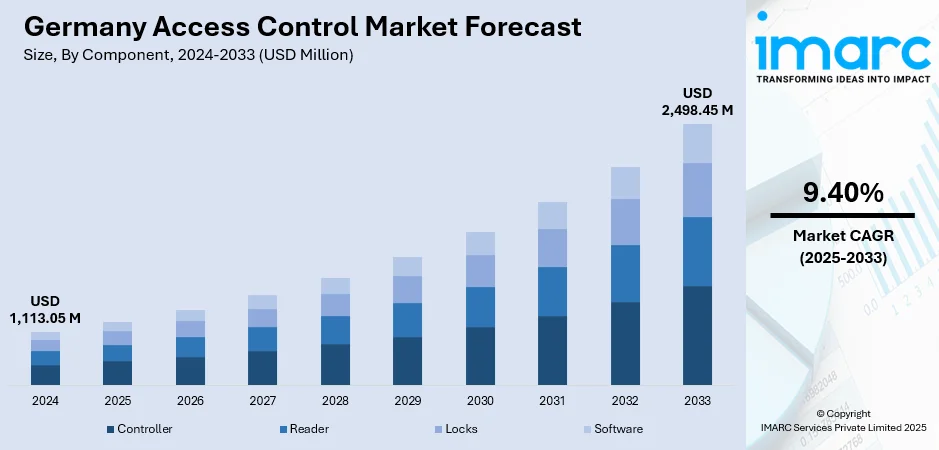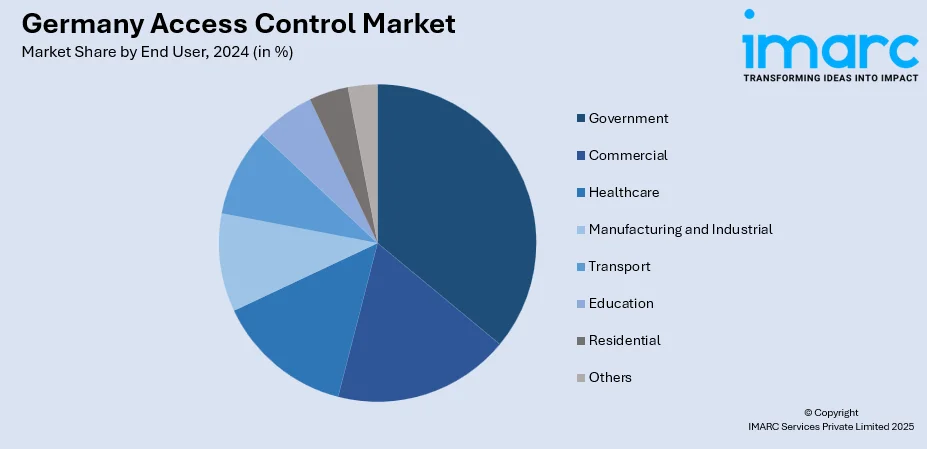
Germany Access Control Market Size, Share, Trends and Forecast by Component, Type, End User, and Region, 2025-2033
Germany Access Control Market Overview:
The Germany access control market size reached USD 1,113.05 Million in 2024. The market is projected to reach USD 2,498.45 Million by 2033, exhibiting a growth rate (CAGR) of 9.40% during 2025-2033. The market is driven by strict data protection and workplace safety regulations (GDPR, DIN/EN standards), rapid digitalization of buildings, and post-pandemic demand for touchless entry. Growth is boosted by Industry 4.0 security needs across factories and logistics hubs, integration of access with video, visitor management, and mobile credentials, and retrofits in aging public infrastructure. Smart city projects, rising cyber-physical threats, and insurance compliance encourage upgrades, while sustainability goals favor energy-efficient, PoE, and cloud-managed systems with analytics and biometrics thus strengthening the Germany access control market share.
|
Report Attribute
|
Key Statistics
|
|---|---|
|
Base Year
|
2024
|
|
Forecast Years
|
2025-2033
|
|
Historical Years
|
2019-2024
|
| Market Size in 2024 | USD 1,113.05 Million |
| Market Forecast in 2033 | USD 2,498.45 Million |
| Market Growth Rate 2025-2033 | 9.40% |
Germany Access Control Market Trends:
Stringent Regulatory and Compliance Frameworks
Germany’s robust legal environment, including the General Data Protection Regulation (GDPR), DIN/EN safety standards, and workplace security laws, strongly influences the Germany access control market growth. Businesses are compelled to adopt secure, privacy-compliant systems that ensure controlled access, detailed audit trails, and data minimization. Public institutions, critical infrastructure, and high-security industries must meet rigorous requirements, prompting investments in advanced solutions. Compliance is not optional non-compliance can lead to substantial fines and reputational damage. As regulations evolve to address cyber-physical security risks, organizations increasingly seek integrated, encrypted access control systems that safeguard both physical premises and personal data. This regulatory push accelerates demand for certified hardware, secure credential management, and centralized monitoring platforms. Vendors offering GDPR-compliant, tamper-resistant solutions with transparent data handling gain a competitive edge in winning contracts across corporate, industrial, and governmental sectors.

To get more information on this market, Request Sample
Industry 4.0 and Smart Infrastructure Integration
The rise of Industry 4.0 in Germany characterized by automation, IoT, and connected industrial systems is a major Germany access control market trend. Factories, logistics hubs, and research facilities require secure yet flexible access systems that integrate with operational technology (OT) and IT networks. Modern solutions enable role-based access, real-time monitoring, and multi-site control from centralized dashboards, ensuring seamless operations without compromising security. Smart infrastructure projects, including airports, railway stations, and urban mobility hubs, increasingly adopt biometric and mobile-based access to enhance user experience and operational efficiency. Interoperability with video surveillance, visitor management, and building automation systems adds value by enabling data-driven decision-making. As cyber threats targeting industrial environments rise, companies prioritize access solutions with strong encryption, AI-based anomaly detection, and compliance certifications, positioning integration-ready platforms as essential to Germany’s smart industrial and public infrastructure evolution.
Demand for Touchless, Mobile, and Sustainable Solutions
Post-pandemic workplace adaptations, combined with Germany’s strong environmental agenda, are transforming access control adoption. Organizations are shifting toward touchless entry methods such as mobile credentials, quick response (QR) codes, and facial recognition to reduce physical contact and enhance convenience. These systems improve hygiene, speed up throughput, and appeal to tech-savvy workforces. At the same time, sustainability targets encourage the use of low-power devices, PoE-enabled readers, and cloud-based systems that reduce hardware footprints and maintenance costs. German cities’ push for energy-efficient smart buildings aligns with access control solutions that integrate occupancy analytics, enabling optimized HVAC and lighting control. Mobile-first platforms also reduce reliance on plastic cards, supporting circular economy goals. Vendors offering secure, scalable, and eco-friendly solutions that comply with GDPR compliance find strong demand across offices, educational institutions, healthcare facilities, and public infrastructure modernizations. This trend blends health, convenience, and environmental priorities into a lasting market driver.
Germany Access Control Market Segmentation:
IMARC Group provides an analysis of the key trends in each segment of the market, along with forecasts at the country and regional levels for 2025-2033. Our report has categorized the market based on component, type, and end user.
Component Insights:
- Controller
- Reader
- Locks
- Software
The report has provided a detailed breakup and analysis of the market based on the component. This includes controller, reader, locks, and software.
Type Insights:
- Card Based
- Contact
- Contactless
- Biometric Based
- Fingerprint
- Face Recognition
- Face Recognition and Fingerprint
- Iris Recognition
- Others
A detailed breakup and analysis of the market based on the type have also been provided in the report. This includes card based (contact, contactless) and biometric based (fingerprint, face recognition, face recognition and fingerprint, iris recognition, and others).
End User Insights:

- Government
- Commercial
- Healthcare
- Manufacturing and Industrial
- Transport
- Education
- Residential
- Others
A detailed breakup and analysis of the market based on the end user have also been provided in the report. This includes government, commercial, healthcare, manufacturing and industrial, transport, education, residential, and others.
Regional Insights:
- Western Germany
- Southern Germany
- Eastern Germany
- Northern Germany
The report has also provided a comprehensive analysis of all the major regional markets, which include Western Germany, Southern Germany, Eastern Germany, and Northern Germany.
Competitive Landscape:
The market research report has also provided a comprehensive analysis of the competitive landscape. Competitive analysis such as market structure, key player positioning, top winning strategies, competitive dashboard, and company evaluation quadrant has been covered in the report. Also, detailed profiles of all major companies have been provided.
Germany Access Control Market News:
- In May 2025, Germany created its first Federal Ministry for Digital and State Modernization, led by tech industry veteran Dr. Karsten Wildberger. The ministry unifies digital policy, oversees state IT infrastructure, and can veto most federal IT spending. Key priorities include a national digital identity wallet and citizen accounts aligned with EU eIDAS standards, aiming to boost secure online access to public services while upholding Germany’s strict data protection and cybersecurity requirements.
- In March 2025, Vodafone Germany opened a Cyber Security Centre in Düsseldorf to protect SMEs, employing over 100 experts for 24/7 threat monitoring, analysis, and incident response. SMEs, vital to Germany’s economy, face rising cyber risks, with over half of attacks targeting them—often during off-hours. Lacking in-house security, these firms can take an average of 21 days to recover from breaches, highlighting the need for dedicated protection services.
Germany Access Control Market Report Coverage:
| Report Features | Details |
|---|---|
| Base Year of the Analysis | 2024 |
| Historical Period | 2019-2024 |
| Forecast Period | 2025-2033 |
| Units | Million USD |
| Scope of the Report |
Exploration of Historical Trends and Market Outlook, Industry Catalysts and Challenges, Segment-Wise Historical and Future Market Assessment:
|
| Components Covered | Controller, Reader, Locks, Software |
| Types Covered |
|
| End Users Covered | Government, Commercial, Healthcare, Manufacturing and Industrial, Transport, Education, Residential, Others |
| Regions Covered | Western Germany, Southern Germany, Eastern Germany, Northern Germany |
| Customization Scope | 10% Free Customization |
| Post-Sale Analyst Support | 10-12 Weeks |
| Delivery Format | PDF and Excel through Email (We can also provide the editable version of the report in PPT/Word format on special request) |
Key Questions Answered in This Report:
- How has the Germany access control market performed so far and how will it perform in the coming years?
- What is the breakup of the Germany access control market on the basis of component?
- What is the breakup of the Germany access control market on the basis of type?
- What is the breakup of the Germany access control market on the basis of end user?
- What is the breakup of the Germany access control market on the basis of region?
- What are the various stages in the value chain of the Germany access control market?
- What are the key driving factors and challenges in the Germany access control market?
- What is the structure of the Germany access control market and who are the key players?
- What is the degree of competition in the Germany access control market?
Key Benefits for Stakeholders:
- IMARC’s industry report offers a comprehensive quantitative analysis of various market segments, historical and current market trends, market forecasts, and dynamics of the Germany access control market from 2019-2033.
- The research report provides the latest information on the market drivers, challenges, and opportunities in the Germany access control market.
- Porter's five forces analysis assist stakeholders in assessing the impact of new entrants, competitive rivalry, supplier power, buyer power, and the threat of substitution. It helps stakeholders to analyze the level of competition within the Germany access control industry and its attractiveness.
- Competitive landscape allows stakeholders to understand their competitive environment and provides an insight into the current positions of key players in the market.
Need more help?
- Speak to our experienced analysts for insights on the current market scenarios.
- Include additional segments and countries to customize the report as per your requirement.
- Gain an unparalleled competitive advantage in your domain by understanding how to utilize the report and positively impacting your operations and revenue.
- For further assistance, please connect with our analysts.
 Request Customization
Request Customization
 Speak to an Analyst
Speak to an Analyst
 Request Brochure
Request Brochure
 Inquire Before Buying
Inquire Before Buying




.webp)




.webp)












